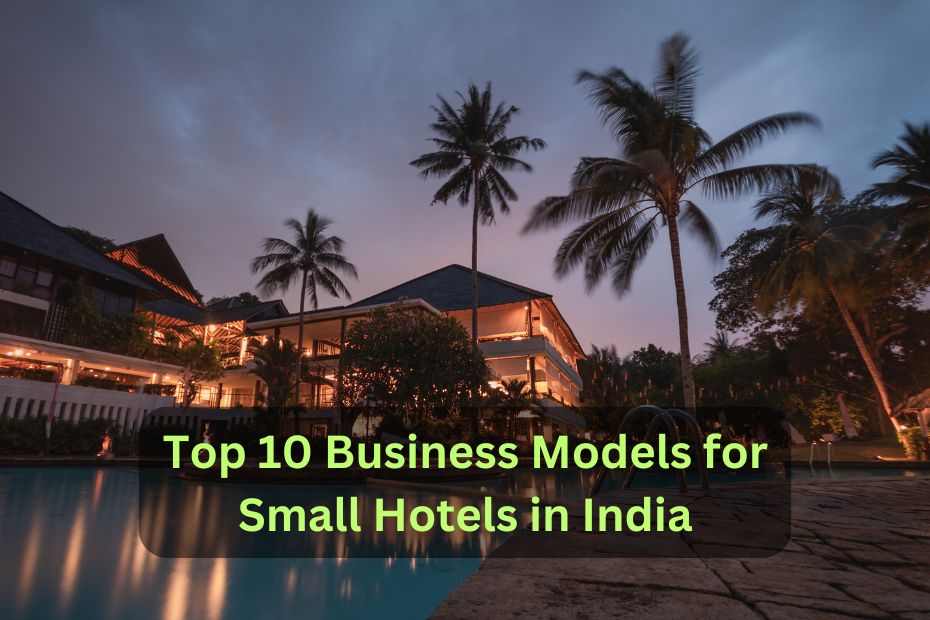India’s tourism sector is growing rapidly, and small hotels have a crucial role in this landscape. However, not all hotels succeed—many struggle due to poor planning and unclear business models. Choosing the right approach can make or break your business.
Here are the top 10 business models for small hotels in India that ensure profitability and long-term success.
1. Independent Boutique Hotel
An independent boutique hotel offers a unique and personalized experience that sets it apart from large chains. These hotels focus on customized service, high-end decor, and local flavors, making them a hit among luxury travelers.
✅ Key Benefits:
- Higher profit margins due to premium pricing
- Strong brand identity and loyal customer base
- Greater flexibility in management and operations
⚠ Challenges:
- Higher initial investment and marketing costs
- Requires strong customer service and branding efforts
2. Bed and Breakfast (B&B)
B&Bs are perfect for budget-conscious travelers who seek a comfortable stay with a homely touch. These hotels typically offer fewer rooms, complimentary breakfast, and a more intimate atmosphere.
✅ Key Benefits:
- Lower operational costs
- High occupancy due to affordable rates
- Personalized guest experiences
⚠ Challenges:
- Limited revenue per guest
- Dependence on seasonal tourism
3. Heritage and Cultural Hotels
India has a rich history, and many old havelis, forts, and palaces are now converted into hotels. These hotels attract heritage tourism seekers looking for authentic experiences.
✅ Key Benefits:
- High appeal among international tourists
- Opportunity for government support and subsidies
- Unique and immersive cultural experiences
⚠ Challenges:
- High restoration and maintenance costs
- Requires specialized marketing strategies
4. Eco-Friendly and Sustainable Hotels
With the rise in environmental awareness, eco-friendly hotels are becoming a profitable niche. These hotels incorporate solar power, rainwater harvesting, and organic farming to minimize their carbon footprint.
✅ Key Benefits:
- Attracts eco-conscious travelers
- Eligible for green certifications and incentives
- Reduces operational costs in the long run
⚠ Challenges:
- Higher initial investment
- Requires constant sustainability efforts
5. Business Hotels
Designed for corporate travelers, business hotels provide work-friendly environments with high-speed internet, meeting rooms, and conference facilities.
✅ Key Benefits:
- Stable occupancy rates throughout the year
- Higher revenue due to premium business services
- Opportunities for partnerships with corporate clients
⚠ Challenges:
- Requires investment in tech and office infrastructure
- Heavy competition in metro cities
6. Resort-Style Hotels
Located in tourist hotspots, resorts offer vacationers a luxurious experience with amenities like pools, spas, and adventure activities.
✅ Key Benefits:
- High profit margins with premium services
- Attracts long-stay guests and honeymooners
- Opportunity for tie-ups with travel agencies
⚠ Challenges:
- Seasonal demand fluctuations
- High maintenance and operational costs
7. Franchise or Chain Hotels
Joining a hotel franchise like OYO, FabHotels, or Treebo gives small hotels access to a recognized brand name, marketing support, and technology integration.
✅ Key Benefits:
- Brand recognition boosts bookings
- Lower marketing expenses
- Easier access to corporate clients
⚠ Challenges:
- Franchise fees and revenue-sharing agreements
- Less control over branding and operations
8. Service Apartments & Long-Stay Hotels
These hotels target business professionals, digital nomads, and families who need a long-term stay with home-like amenities.
✅ Key Benefits:
- Steady revenue from long-term guests
- Lower operational costs compared to traditional hotels
- Rising demand due to remote work culture
⚠ Challenges:
- Requires large initial investment in infrastructure
- Limited revenue from short-term travelers
9. Budget Hotels
Budget hotels cater to backpackers, students, and low-budget travelers looking for affordable yet comfortable accommodations.
✅ Key Benefits:
- High demand in tourist-heavy locations
- Simple business model with fewer luxury requirements
- Easy to scale with multiple properties
⚠ Challenges:
- Low-profit margins
- High competition with online aggregators
10. Hostel & Co-Living Spaces
A hostel or co-living space provides affordable stays with shared rooms, dorms, and communal areas, attracting solo travelers and digital nomads.
✅ Key Benefits:
- High occupancy rates due to affordability
- Strong sense of community and social interactions
- Lower maintenance costs compared to hotels
⚠ Challenges:
- Managing guest interactions and shared spaces
- Requires strong social media and word-of-mouth marketing
Conclusion
Choosing the right business model for your small hotel in India depends on location, target audience, and investment capacity. Whether you opt for a luxury boutique hotel, a budget-friendly hostel, or a business-oriented hotel, success lies in understanding customer needs and delivering exceptional service.
FAQs
What is the most profitable business model for small hotels in India?
Boutique hotels and business hotels often yield the highest profits due to premium pricing.
2. How can small hotels compete with large hotel chains?
By offering unique experiences, personalized service, and a niche market focus.
3. Are franchise hotels a good option for small hotel owners?
Yes, if you want brand recognition and marketing support without handling everything alone.
4. What is the best business model for hotels in rural areas?
Heritage hotels and eco-friendly resorts work well in rural or culturally rich locations.
5. How can I attract more guests to my small hotel?
Focus on strong online marketing, guest reviews, and partnerships with travel agencies.
